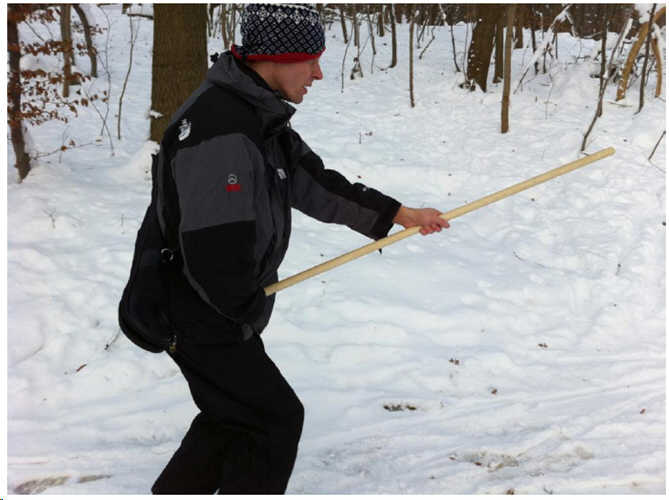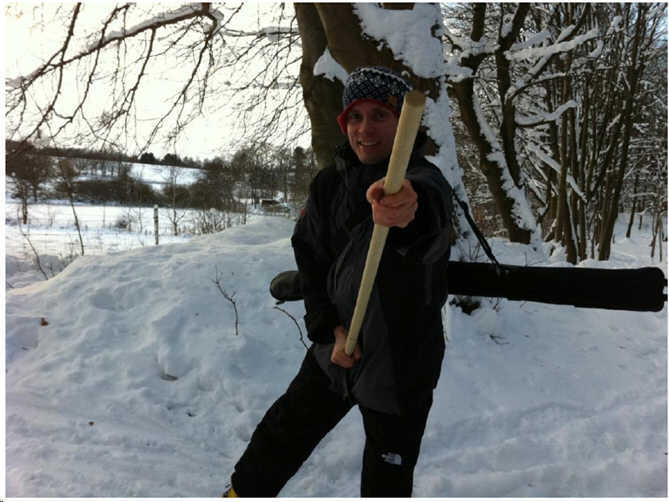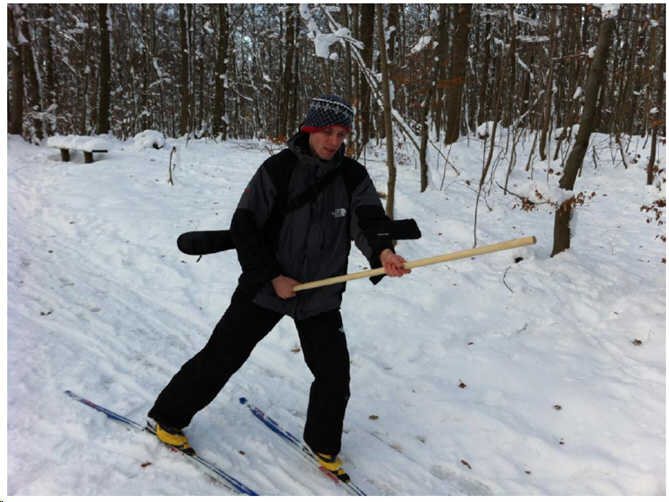
By Christian H. Olsen, Member until 2022
From the day Kjeld Renshi-dai told me that there would be a Jo course and that I would have the opportunity to be taught by Kimu Sensei himself, I felt grateful. It's not every day 1 hour of teaching is worth 1000 hours of training.
The preparation essentially consisted of choosing the Jo (wooden staff) that would follow me through life. I knew as soon as I saw the closely spaced and streamlined veins in the Japanese white oak that this particular Jo should be a tool for learning. The source of learning was 1000 years of martial arts passed down in its essence by Kimu Sensei, and the matter to be shaped is my training buddies and myself.
The course was planned for two times three hours, respectively on 26 Nov. and 10 Dec. 2010 at 16-19.
The course started with Jo-jutsu theory and a brief historical overview. Initially, our sense of reality was tested. It is said philosophically that autonomy (read: freedom of action) presupposes free logical thinking, critical (self) reflection and independent decision-making. Our ability to see things as they are was put to the test by Kimu Sensei. The vast majority of us did not see the forest for the trees or the truth in the story of the Jo. So in the story of Musubi with Jo against Mosashi with Katana.
On the Jo course 1.1, we were made familiar with the Jo and learned the basic starting and fighting positions, e.g. Sage jo no kamae (stick in the ground with contact to the outside of the foot behind the base of the little toe), Ritsu jo no kamae (staff behind back), with change of staff next to sternum and heart with right hand over left in defensive or right hand under left in offensive kamae) to Tsune no kamae (staff at dragon point pointing at opponent's evil eye). After that we slipped into one Yari jo no kamae with right wrist in right groin, and left hand (middle of Jo) in chudan, or (top 1/3 up) in jodan, or (bottom 1/3) in gedan. Then we learned Ken kotachi jo no kamae with Tea pot-arms, both in chu-, jo- and gendan with thrusts against jodan (neck), chudan (solar plexus), and gedan (inside of knee). There were thus many common features with the sword course, but of course also other ways of handling the walking stick.
The tool was different, but the grip and base were the same, just from the current starting point.
We trained both standing one-step actions, including going back in Kokutsu-dachi and forth in Zenkutsu-dachi. Then we trained Shiho level 3 steps with crossovers, Three step exercises (Sanbon Kihon Kumite) We trained cross tension, basics, as well as fighting technique and understanding, using the TAK-MYT-CT principles. In addition, we learned two old health exercises affecting all twelve meridians, namely Mai Tai Ori (staff over bladder) and Uchiro Tai Ori (stick behind back) off Heiko dachi.
Between the two courses I trained with my Jo, specially Kokutsu-Zenkutsu dachi shift /tension; possibly see pictures.
On the second day of the course (Jo-Jutsu course package 1.2) the teaching, as usual, went much faster than on the first day of the course 14 days before. Here, Jens Kyoshi masterfully showed a re-cap of the techniques shown from the first day of the course (Jo-Jutsu course package 1.1). Kimu Sensei supplemented with key and energy points, as well as gave a spiritual introduction to the upcoming learning, so that we all got great motivation and were open and receptive to the transmission of more than 1000 years of Jo teachings.
On course day two, we learned 'the wildest' fighting positions, i.a. Hasso no kamae lying on respectively left and right upper arm i oops and gyaku with 'double' tension in the hip via two fluid passages of movement from Zenkutsu-dachi (with 70-30% front/rear leg weight distribution) over Kokutsu-dachi (30-70%) to 'original' narrow Zenkutsu dachi (50-50%) dachi until release of energy e.g. with downward parade/stroke in Neko-ashi dachi. The latter position also applied during execution of Age week Yes, technique with retraction of the front foot, which grabs the front ankle as if with a rope and pulls it in with the sole of the foot sliding over ground of beetles and space for rice paper under the heel for weight distribution on (10-90%), and could be followed up by e.g. a Jo-Tsuki (with power from hip rotation out through the three star points in the shoulder, upper arm and forearm) i Kake-dachi, of course with correct center and timing.
Before that we trained standing up Uchi- and Sotu week from first Yari-also Ken/Kotachi jo no kamae respectively chudan, gedan and iodine, where the focal point for correct technique was that the energy out into the Jo tip comes from the very center of ourselves. After that, we trained walking one- and three-step techniques, first without and then with con-kullega (partner/opponent) of 20, 50 and 80% respectively. During the entire course, we trained from the ground up on various Taisabaki levels, mainly level 1-3; see syllabus description.
Kimu Sensei showed how effective correct base is even at 20% speed or actually slower where Oliver B. flew back despite simple Shuto attack technique performed with constant contact until power transfer in slow motion. It was a real 'James Bond' trick or rather masterful (read:Inca) knowledge, skills and execution of correct basic technique.
One of the secrets was (besides correct TAK-MYT-CT) power transfer in a very small contact point, hence great effect despite technique performed very slowly. As Kimu Sensei said, it's not rocket science. Whether it is simple is another question. I imagine that some of the prerequisites for being able to perform such a technique are to be in complete balance, to know yourself and the other person, and then perform your base completely correctly according to the above principles.
'Everything is easy for those who can do it', said my old maths teacher Mr Bramsgård with an inexplicable smile. I hardly dare think of the effect of such a technique with 100% clarification and power performed at the right time and place; (read: as a defense to survive in a life-or-death situation.)
Finally, we were taught how to handle a stick with a change from right to left side, in turns with a stick over the head (Oku-Jo dan no Kamai), i Sasakakura Jo-no Kamai and in the performance of original samurai health and ki exercises, including repetition of the two exercises from the first day of the course (now with breathing instructions and triangle explanation: Kata guru(t/s)ogami (rod behind shoulder and neck-yoke) with lateral rotation of the upper body in relation to the hip under a constantly forward-pointing navel or The aunt from Heiko-dachi, then Shitsugan (Eyes-on-knees-exercise) pole behind lower back/'cross tailbone';-) with bent arms and hands as if holding a beach ball doing lateral rotation from Sankaku dachi (short triangle leg pose), and Shito ake and Hitotsu(gedan) uke (Ki I-ai – Ai-i -exercise) from Kiba-dachi on toes in balance with raising staff to above clavicle with medial side of wrist and lowering Jo staff horizontally to above bladder with ulnar side of wrist.
After hours of full concentration with tiredness in the body and heaviness in the head, after performing the health exercises I felt light in the head and fresh in the body, and ready for whatever it might be.
During the X-mas camp 2010, Kimu Sensei showed his magnanimity and gave the essence of Jo-Jutsu course package 1 on a silver platter for the Brown and Black Belts during well over an hour of teaching. Everyone who wanted to be successful and had dreams of being James Bond, Charlie's Angels, Robin Hood and Little John, or 'just' their own super-hero, pricked up their ears and imitated the demonstrations as best they could. Kimu Sensei said that he had evolved by doing what his teachers showed him and preferably even better to honor them and the teachings passed down. He wants us to do that too. In the moments I managed to let go of my own limiting beliefs, I felt like I was taking seven-mile steps in developing my base. At times it was almost a seven-millimeter (back and forth) step, but where nothing dares nothing wins, and where there's a will there's a way.
And as Kimu Sensei said, 'Use Yakami- and now Yes-training as a tool in your life'. And something like: 'Here you can freely test yourself and your limits in a so-called Shindenkan free space (without the risk of fatal consequences in the past). Here you can learn from your own and others' experiences and take them with you and use them in your life for your and others' good.


Thank you very much(Many thanks) for a good Jo-jutsu course for Kimu Sensei and Jens Kyoshi. For me, it's (once again) about keeping it simple for myself and others, recognizing that the deep plate is invented, trusting that others want me well, gratefully accepting the gifts that are given to me and mine, showing respect by taking responsibility for the abilities and opportunities given to me and showing generosity by passing on my surplus. In short, be a good role model by saying as I do and doing as I say. That was actually the real reason why I started training at Jokokan Frederiksberg for approx. 6 years ago. When it consistently succeeds, I think I am the hero I really want to be deep down. And I wonder if other challenges will appear as I get to know myself and others better, so I guess I can train that for the rest of my life - inside and outside Shindenkan. |




